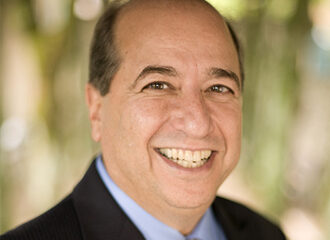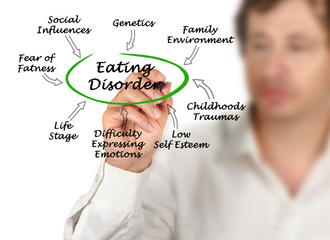 Written by: Samantha DeCaro, PsyD
Written by: Samantha DeCaro, PsyD
Director of Clinical Outreach and Education,
The Renfrew Center
Orthorexia Nervosa (ON), a term coined by Dr. Steven Bratman, MD over twenty-five years ago, is characterized by an obsession with consuming only “healthy” food, with a focus on the quality and purity of it.
Can Orthorexia Be Diagnosed?
Orthorexia is not yet included as a standalone diagnosis in the DSM-5, however those who are struggling with these thoughts and behaviors often meet diagnostic criteria for an Other Specified Feeding or Eating Disorder (OSFED), a diagnosis used for those who do not fit neatly in the Anorexia Nervosa (AN), Bulimia Nervosa (BN) or Binge Eating Disorder (BED) categories.
What Makes Orthorexia Dangerous?
The various physical, mental and social consequences of orthorexia are just as serious and debilitating as any other eating disorder. Those with orthorexia will often create extremely rigid rules about food in hopes of achieving optimal health.
Although malnourishment and weight loss are common side effects of orthorexia, those with this disorder are not necessarily trying to restrict calories or change the size of their bodies. These rigid behaviors seem to be primarily rooted in the pursuit of “wellness” rather than thinness. Paradoxically, this pathological fixation on “healthy” eating often causes the same medical, psychological and social complications we see with anorexia nervosa or other restrictive eating disorders.
What Are the Warning Signs of Orthorexia?
Here are some of the potential warning signs that you or someone you know may be suffering from orthorexia:
- Restricting foods or entire food groups that are deemed “unhealthy” or “bad”
- Obsessing about eating “clean,” organic, “whole,” “pure,” and/or unprocessed food
- Spending inordinate amounts of time buying, preparing and cooking foods
- Having an irrational fear that eating even small amounts of certain foods will result in a serious health issue
- Preoccupation with “gut health,” food allergies and/or food intolerances without having a legitimate medical diagnosis
- Compulsively consuming products that claim to “detox,” “boost,” “purify,” or “cleanse” the system
- Experiencing intense anxiety, distress, guilt, shame, and/or fear associated with consuming “unhealthy” food
- Avoiding restaurants and/or social events due to a fear of being in the presence of forbidden foods
- Sustaining mental and medical issues secondary to malnourishment, such as low heart rate, depression, anxiety, weight loss, and/or thinning hair
What Causes Orthorexia?
There is no known cause for orthorexia or any other eating disorder. Eating disorders are complex psychiatric conditions, and there are numerous risk factors that likely converge to create the perfect storm for both their onset and maintenance.
Psychology, Sociology & Genetics
Psychological, cultural, genetic, sociological, and neurobiological factors can all potentially increase someone’s vulnerability to developing an eating disorder. A life stressor, or even simply trying a new fad diet, can potentially trigger orthorexia at any point in the lifespan.
Age-Related
For teenagers and young adults, these triggers vary, but could include developmental milestones such as hitting puberty or moving away from home for the first time. Folks in midlife face similar transitions and stressors, such as divorce, loss, infidelity, post-partum changes, menopause, and the natural effects of the aging process.
Wellness Culture
The distress, fear or anxiety caused by these events is only worsened by the incessant messages that it is our duty to prioritize and optimize our physical health. The multibillion-dollar diet and wellness industries, along with the ideological concept of “healthism,” all contribute to the development and maintenance of orthorexia.
These oppressive forces fuel and reinforce obsessive pursuits of health; the symptoms of orthorexia could be conceptualized as subconscious attempts to measure up in a society that equates health with romanticized character traits, such as morality, purity, and self-discipline. The diet and wellness industries also heavily market appropriated “superfoods,” while touting unfounded claims that certain ingredients have the power to cure or prevent various medical and psychological ailments. These advertisement campaigns only serve to strengthen the obsessive thoughts, fears and compulsive behaviors associated with orthorexia.
How is Orthorexia Treated?
A thorough assessment by an eating disorder provider can help provide an OSFED diagnosis for orthorexia (as well as any other comorbid conditions) and determine the appropriate level of care to begin the medical and psychological healing process. If diagnostic criteria are not fully met, it’s important to remember that everyone deserves to experience a peaceful relationship with food. If this is the case, consider enlisting the support of an experienced therapist and/or dietician who specializes in disordered eating.
Treatment Levels
Levels of care can range from weekly appointments with an outpatient team, an intensive outpatient program (IOP), a partial hospitalization program (PHP), a residential program (RES), or in severe cases, an inpatient hospitalization setting (IP). An eating disorder treatment team at the outpatient level usually consists of a therapist, a registered dietitian, a PCP, and a psychiatrist (if needed) to address the various medical, nutritional, and deeper psychological components of orthorexia recovery.
Attitudes Toward Food
An important part of the work in orthorexia recovery includes unpacking and challenging internalized beliefs rooted in healthism, while implementing exposures to a wide variety of foods. There are no foods that are considered “unhealthy” in orthorexia recovery (excluding a legitimate allergy or medical condition), which may seem disorienting at first to those who have been exposed to inaccurate dietary theories or nutritional misinformation. Allowing food to be a source of pleasure, celebration, culture, and connection gradually repairs the damaged relationship with it.
Emotional & Mental Aspects
Orthorexia recovery is not just about eating food, and like other eating disorders, deeper emotional and relational components must be addressed. Spending inordinate amounts of time and using up mental space to eat as “healthy” as possible can serve as a distraction from painful emotional experiences below the surface.
The practice of accepting, identifying, expressing, and building tolerance to emotional experiences can help the orthorexia behaviors lose their power. Other parts of the therapeutic work might include improving self-esteem, challenging perfectionism, identifying interests beyond food, and clarifying more meaningful core values.
Conclusion
Orthorexia can affect any age, race, gender, or weight and can cause significant harm physically, mentally and socially. Although the cause is not fully understood, “wellness culture” and “healthism” both contribute to the cycle of disordered eating by idealizing certain foods, demonizing others and elevating the moral status of health-focused individuals.
Orthorexia can cause extreme emotional distress, rapid weight loss and malnutrition, which are all harmful consequences regardless of body size. It’s crucial that clinicians examine their own biases and internalized fatphobia, as to not interfere with or delay a proper diagnosis or treatment plan. By targeting the medical, nutritional, and psychological factors at play with the support of an experienced treatment team, recovery from orthorexia is possible.


